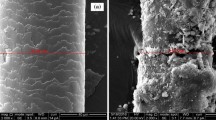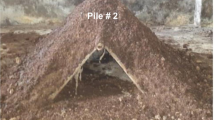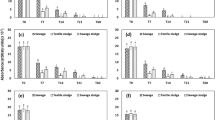Abstract
Production of waste hair in the leather manufacturing industry is increasing every year due to the adoption of hair-save unhairing techniques, leaving the tanners with the problem of coping with yet another solid by-product. Numerous potential strategies for hair utilisation have been proposed. However, the use of hair waste as agricultural fertiliser is one of its most promising applications due to the high nitrogen content of hair. Agricultural value of hair can be increased by composting. This paper deals with the composting of hair from the unhairing of bovine hide. Results indicated that hair cannot be either composted on its own or co-composted with de-inking sludge, a chemical complementary co-substrate. However, good results were obtained when co-composted with raw sludge from a municipal wastewater treatment plant at hair:raw sludge weight ratios 1:1, 1:2 and, 1:4 in lab scale and pilot plant scale composters. In all cases, a more stable product was achieved at the end of the process. Composting in the pilot plant composter was effectively monitored using Static Respiration Indices determined at process temperature at sampling (SRI T ) and at 37°C (SRI37). Notably, SRI T values were more sensitive to changes in the biological activity. In contrast, Respiratory Quotient (RQ) values were not adequate to follow the development of the process.
Similar content being viewed by others
References
Adani F, Gigliotti G, Valentini F, Laraia R (2003) Respiration index determination: a comparative study of different methods. Compost Sci Util 11:144–151
Agnew JM, Leonard JJ, Feddes J, Feng Y (2003) A modified air picnometer for compost air volume and density determination. Can Biosyst Eng 45:6.27–6.35
Adams, RC, MacLean FS, Dixon JK, Bennett FM, Martin GI, Lough RC (1951) The utilization of organic wastes in N.Z.: second interim report of the inter-departmental committee. New Zealand Engineering November 15:396–424
Atkinson B, Mavituna F (1983) Biochemical engineering and biotechnology Handbook. Nature Press, NY
Barrena Gómez R, Vázquez Lima F, Gordillo Bolasell MA, Gea T, Sánchez Ferrer A (2005) Respirometric assays at fixed and process temperatures to monitor composting process. Biores Technol 96:1153–1159
Barrena Gómez R, Vázquez Lima F, Sánchez Ferrer A (2006) The use of respiration indices in the composting process: a review. Waste Management Res 24:37–47
California Compost Quality Council (2001) Compost maturity index. URL: http://crra.com/ccqc/ccqchome. htm
Charest MH, Beauchamp CJ (2002) Composting of de-inking paper sludge with poultry manure at three nitrogen levels using mechanical turning: behavior of physico-chemical parameters. Biores Technol 81:7–17
Charest MH, Antoun H, Beauchamp CJ (2004) Dynamics of water-soluble carbon substances and microbial populations during the composting of de-inking paper sludge. Biores Technol 91:53:67
Cronje AL, Turner C, Williams AG, Barker AJ, Guy S (2004) The respiration rate of composting pig manure. Compost Sci Util 12:119–129
Galarza BC, Goya LM, Cantera CS, Garros ML, Reinos HE, López LMI (2004) Fungal biotransformation of bovine hair Part 1: isolation of fungus with keratinolitic activity. partial characterization of crude fungal extracts. J Soc Leather Technologists Chemists 88:93–98
Gea T, Barrena R, Artola A, Sanchez A (2004) Monitoring the biological activity of the composting process: Oxygen Uptake Rate (OUR), Respirometric Index (RI), and Respiratory Quotient (RQ). Biotechnol Bioeng 88:520–527
Gea Leiva T, Artola Casacuberta A, Sánchez Ferrer A (2003) Application of experimental design techniques to the optimization of bench-scale composting conditions of municipal raw sludge. Compost Sci Util11:321–329
Gea T, Artola A, Sánchez A (2005) Composting of de-inking sludge from the recycled paper manufacturing industry. Biores Technol 96:1161–1167
Gousterova A, Braikova D, Goshev I, Christov P, Tishinov K, Vasileva-Tonkova E, Haertle T, Nedkov P (2005) Degradation of keratin and collagen containing wasted by newly isolated thermoactinomycetes by alkaline hydrolysis. Letters Appl Microbiol 40:335–340
Haug RT (1993) The practical handbook of compost engineering. Lewis Publishers, Boca Raton, Fl
Hsu J, Lo S (1999) Chemical and spectroscopic analysis of organic matter transformation during composting of pig manure. Environ Pollut 104:189–196
Iannotti DA, Pang T, Toth BL, Elwell DL, Keener HM, Hoitink HAJ (1993) A quantitative respirometric method for monitoring compost stability. Compost Sci Util 1:52–65
Jokela J, Rintala J, Oikari A, Reinikainen O, Mutka K, Nyronen T (1997) Aerobic composting and anaerobic digestion of pulp and paper mill sludges. Water Sci Technol 36:181–188
Klauss M, Papadimitriou EK (2002) Determining the degree of aerobiosis in composting material. Bioprocessing Solid Waste Sludge 2:37–47
Laos F, Mazzarino MJ, Walter I, Roselli L, Satti P, Moyano S (2002) Composting of fish offal and biosolids in northwestern Patagonia. Biores Technol 81:179–186
Madejón E, Díaz MJ, López R, Cabrera F (2002) New approaches to establish optimum moisture content for compostable materials. Biores Technol 85:73–78
Mönning K, Kuhne M, Bidlingmaier W (2002) Composting of municipal bio-waste: the influence of temperature, O2 and CO2 content and the respiratory quotient in the thermophilic stage. In: Michel FC, Rynk RF, Hoitink HAJ (Eds) Proceedings of the 2002 international symposium composting and compost utilization. JG Press, Emmaus, Pa
Nakasaki K, Shoda M, Kubota H (1985) Effect of temperature on composting sewage sludge. Appl Environ Microbiol 50:1526–1530
Oppenheimer J, Martin J, Walker L (1997) Measurements of air-filled porosity in unsaturated organic matrices using a pycnometer. Biores Technol 59:241–247
Pagans E, Barrena R, Font X, Sánchez A (2006) Ammonia emissions from the composting of different organic wastes. Dependency on process temperature Chemosphere 62:1534–1542
Rivela B, Moreira MT, Bornhardt C, Méndez R, Feijoo G (2004) Life cycle assessment as a tool for the environmental improvement of the tannery industry in developing countries. Environ Sci Technol 38:1901–1909
Salter C, Cuyler A (2003) Pathogen reduction in food residuals composting. Biocycle 44:42–50
Scaglia B, Tambone F, Genevini PL, Adani F (2000) Respiration Index determination. Dynamic and static approaches. Compost Sci Util 8:90–98
Sharma VK, Canditelli M, Fortuna F, Cornacchia G (1997) Processing of urban and agroindustrial residues by aerobic composting: Review. Energy Conversion Manage 38:453–478
Sánchez-Monedero MA, Roig A, Paredes C, Bernal MP (2001) Nitrogen transformation during organic waste composting by the Rutgers system and its effects on pH, EC and maturity of the composting mixtures. Biores Technol 78:201–308
Tiquia SM, Ichida JM, Keener HM, Elwell DL, Burttt EH, Michel FC (2005) Bacterial community profiles on feathers during composting as determined by terminal restriction fragment length polymorphism analysis of 16S rDNA genes. Appl Microbiol Biotechnol 67:412–419
US Department of Agriculture & US Composting Council (2002) Test Methods for the examination of composting and compost (TMECC). Edapho International, Houston, USA
Venglovsky J, Sasakova N, Vargova M, Pacajova Z, Placha I, Petrovsky M, Harichova D (2005) Evolution of temperature and chemical parameters during composting of the pig slurry solid fraction amended with natural zeolite. Biores Technol 96:181–189
Vidal G, Nieto J, Cooman K, Gajardo M, Bornhardt C (2004) Unhairing effluents treated by an activated sludge system. J Hazardous Mat B112:143–149
Wakelin NG, Forster CF (1997) An investigation into microbial removal of fats, oils and greases. Biores Technol 59:37–43
Acknowledgments
The authors thank the interest of Miquel Vila from Igualadina de Depuració i Recuperació S.L: in the development of this work. The financial support from the Spanish Ministerio de Ciencia y Tecnología (Project REN2003-00823) is also acknowledged.
Author information
Authors and Affiliations
Corresponding author
Rights and permissions
About this article
Cite this article
Barrena, R., Pagans, E., Artola, A. et al. Co-composting of hair waste from the tanning industry with de-inking and municipal wastewater sludges. Biodegradation 18, 257–268 (2007). https://doi.org/10.1007/s10532-006-9060-z
Received:
Accepted:
Published:
Issue Date:
DOI: https://doi.org/10.1007/s10532-006-9060-z




